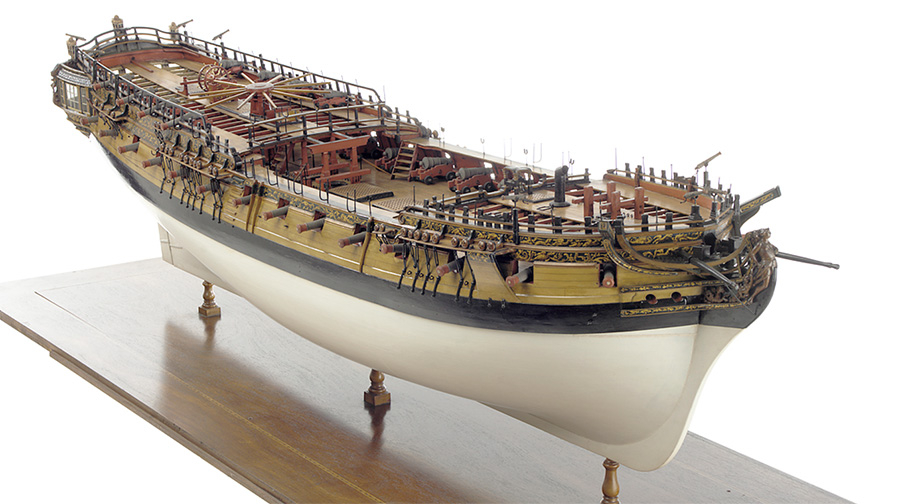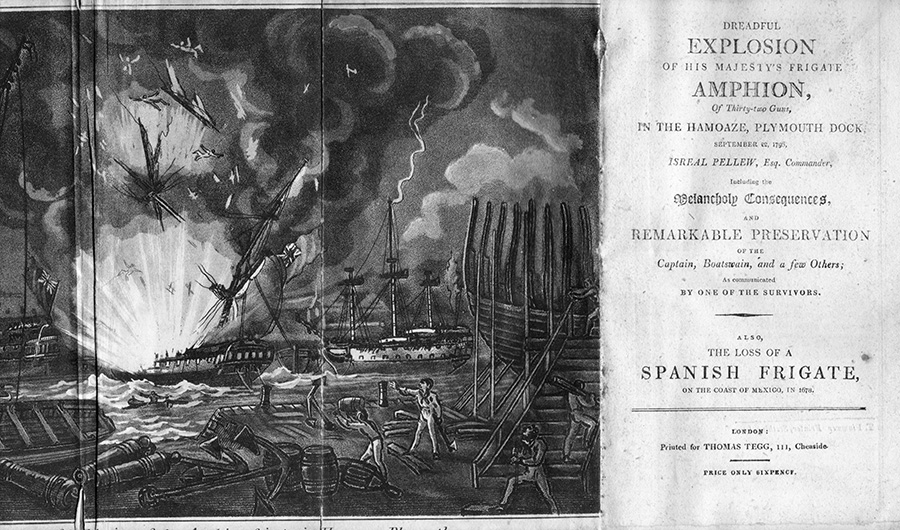HMS Amphion
HMS Amphion was one of a large number of 32 gun fifth rate Amazon class frigates built to a Williams design. Amphion was ordered in June 1778, built in Chatham and launched in December 1780 at a cost £16,580.13.5d including fitting and coppering. Named after the classical Greek hero, this Amphion was the first of her name in Royal Navy service.
By 1796, the Amphion was under the command of Captain Israel Pellew, he had just returned from Newfoundland and recently been given orders to join his brother Edward's squadron in the English Channel. On the way she damaged her foremast in a gale and the Amphion had to return to Plymouth, arriving on 19th September and heading up to Dock (Devonport) for repairs the next morning. At that time there were rumours that the French were going to invade Ireland so Plymouth was busy embarking troops to reinforce the garrisons there, so the dockyard and Hamoaze were full of ships and boats coming and going. A few yards from the Dockyard jetty the Amphion was brought alongside a sheer-hulk, the old receiving ship Yarmouth, which could be used as a crane to lift heavy masts and spars.
Israel Pellew was the brother of Capt. Edward Pellew who was instrumental in saving so many lives during the wrecking of the Dutton East Indiaman in Plymouth in January 1796.
As the frigate was due to leave the next day she was crowded with more than an hundred men, women, and children who were friends and relatives of the crew. Captain Pellew had also arranged a small farewell dinner party to which he invited a number of friends and colleagues.
The Explosion
It was the anniversary of King George III's coronation so the warships in the harbour had fired a noisy royal salute that morning. But an eyewitness tells how he was just sitting down to dinner when he heard a much larger explosion which shook the house and rattled the windows like an earthquake. The Amphion frigate had blown up without warning.
A midshipman on another warship nearby was watching Amphion through a telescope. The repairs being made to the bowsprit seemed to be coming along well when Amphion appeared to rise up out of the water almost to her keel, her foremast shot upwards out of the ship and she settled back down and sank bow first in under two minutes.
At the dinner party, only Captain Pellew, his first lieutenant and Captain Swaffield of the Dutch 64 gun ship Overijssel had arrived so far. They had just sat down when they were thrown from their chairs by the violent explosion and were dashed against the deckhead above. Pellew got up, his face badly cut and bruised, and made his way to the stern windows before throwing himself out towards a hawser hanging close to the stern gallery. Pellew managed to grab the thick rope before dropping into the sea. The explosion had attracted all the small boats plying to and from the warships in the harbour so Pellew was soon plucked from the water. Shocked, battered, cut about and largely insensible, the soaking wet Pellew was carried to Commissioner Linshaw's house in the dockyard where his wounds could be treated.

A model of an Amazon class frigate (NMM)
The first lieutenant who was dining with the Captain followed Pellew out of the stern windows but he had the advantage of being a remarkably good swimmer so managed to save himself. Unfortunately the visiting Captain Swaffield did not manage to escape, it was thought that he had been more severely injured when he was thrown against the ceiling as his body was found a month later with fractures to the skull.
There were many lucky escapes. The marine sentry outside the door where the dinner party was going on was looking at his watch when the ship blew up, he survived but had no idea how he managed to escape as the last thing he remembered was his watch being knocked out of his hand. The sentry on the gangway was blown straight over to the hulk that was tied up alongside and arrived completely undamaged. At that time, Mr Montandon the Amphion's boatswain was standing on the cathead supervising repairs; the bowsprit had recently been stepped and the gammoning had been put on so he was directing the men rigging out the jib-boom. The boatswain was thrown upwards by the explosion that had happened right under his feet and was thrown into the sea in a mass of rigging. Montandon struggled to get free but was soon picked up by a ship's boat whereupon they found that he had his arm broken in the fall. Three or four of the crew who were working in the tops repairing the rigging were also blown into the sea and picked up largely undamaged. Captain Joshua Rowley was on his way to join Pellew's dinner-party, he was in his boat within a few yards of the Amphion when the ship blew up. The others that had been invited to the party who were late or had other engagements also had a miraculous escape.

Tegg's account of the loss of the Amphion (SHIPS Project)
The Amphion blew up suddenly in a very busy harbour, with a hulk lashed on one side, surrounded by ships and small boats and close to the jetty, yet the only damage sustained was to the Amphion herself. The Yarmouth was undamaged but was covered in wreckage and the gruesome remains of bodies blackened and shattered by the huge explosion. Bodies and wreckage were thrown into the sea and were then picked up by the boats in Hamoaze. The few crew members who remained alive were taken to the Royal Hospital in Plymouth where many died later of their wounds.
Loss of Life
Everyone in Devonport had heard and felt the massive explosion and soon there were distraught relatives at the dockyard gates trying to find out if friends and relatives were still alive. But the only survivors were captain Pellew, two lieutenants, a boatswain, three or four seamen, a marine, one woman and a child. No-one knew how many people were on board the frigate at the time of the explosion but it was estimated that 278 lost their lives of which many were residents of Plymouth Dock (Devonport); Amphion had been based at Plymouth for some time and the crews had formed numerous connections and acquaintances amongst the locals. Many of the crew had survived as they had not been needed on board that day, they were ashore with their friends and relations saying goodbye as they were due to sail the next morning.
The three towns of Plymouth, Plymouth Dock and Stonehouse were not very large in 1796 so the loss of over 200 of their people would have affected everyone, Plymouth Dock went into mourning and the following day half the shop windows in Fore Street had their shutters closed. Many bodies were not recovered immediately as they had been trapped inside the ship but one or two were occasionally picked up in the river for some weeks afterwards.
Salvage
The next day found the Amphion sunk on the seabed with just a foot of one of her masts visible above water. The dockyard workers started to collect the debris blown from the ship and scattered over the river as well as dragging what they could from the deck of the sunken frigate. The wreck of the Amphion had to be removed; it was a large obstruction in shallow water that was blocking access to the dockyard. The wreck could not be blown up as it was too close to the shore so the frigate had to be lifted from the riverbed and moved out of the way. On 3rd October the two frigates Castor and Iphigenia were brought alongside the Amphion and were lashed to two stout rope cables that had previously been swept under the wreck, with one cable under her bow and one under her stern.
The two floating frigates had been prepared by having everything moveable taken out of them and their gunports closed and sealed to make them watertight. With one each of the modified frigates on each side of the wreck they were filled with water to make them sink as low in the water as possible. At low tide the ropes under the wreck were hauled taut using men heaving on capstans, the ropes were made fast then the water used to fill the two frigates was pumped out. The ropes held, and as the tide came in and the two frigates were emptied the Amphion was raised from the bottom of the river. The three ships lashed together were towed into shallow water where the Amphion could be beached. With the wreck on the foreshore it could be reached at low water so dockyard workers proceeded to break her up where she lay.
Cause of Loss
Eyewitnesses said that they saw the foremast blown into the air when the ship exploded so it is thought that the explosion happened in the foreward magazine. The ship was about to sail the next morning so the magazine at the time would have been fiull, holding 32 rounds of ammunition for each of the 38 guns she carried. The first lieutenant was responsible for the security of the magazines and it was initially thought that the explosion happened due to his negligence. But the court martial found that the gunner had drawn the keys to the magazines that morning without the knowledge or permission of the first lieutenant, the gunner had been cleaning the guns that day so would need to stow any loose powder he collected in the magazine. However, Capt. Pellew had previously complained that the magazine was unsafe and questioned the decision of the court martial.
What really happened will never be known as the gunner was one of the crew who lost his life in the accident. It was later reported that a sack had been dredged up from near the wreck that contained gunpowder covered over at the top with ships biscuit, suggesting that the gunner had been stealing powder to sell. It is also alleged that the gunner had been seen in town that morning much the worse for drink so perhaps he was less careful than usual when handling powder in the magazine which resulted in the fatal explosion.
Amphion's noble sons, no longer now,
shall weave fresh garlands for Britannia's brow;
Your pointed thunder, now no more shall roar
and carry terror to each hostile shore.
by A Constant Reader (Naval Chronicle)
Captain Pellew went on to command the Conqueror (74) at the Battle of Trafalgar, successor to the RN third rate Conqueror (68) wrecked on Drakes Island. Israel became Admiral Sir Israel Pellew KCB RN, and finally died in Plymouth in 1832.
